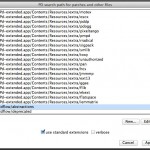This is a more or less finished version of the Kinect for Processing library. It includes the basic skeleton tracking, the RGB image, depth image and a mask image. I shall move the related posts to the research page with more documentation on the data structure and method description. Stay tune.
The sample Processing code:
import pKinect.PKinect; import pKinect.SkeletonData; PKinect kinect; PFont font; ArrayList<SkeletonData> bodies; PImage img; void setup() { size(640, 480); background(0); kinect = new PKinect(this); bodies = new ArrayList<SkeletonData>(); smooth(); font = loadFont("LucidaSans-18.vlw"); textFont(font, 18); textAlign(CENTER); img = loadImage("background.png"); } void draw() { background(0); image(kinect.GetImage(), 320, 0, 320, 240); image(kinect.GetDepth(), 320, 240, 320, 240); image(img, 0, 240, 320, 240); image(kinect.GetMask(), 0, 240, 320, 240); for (int i=0; i<bodies.size(); i++) { drawSkeleton(bodies.get(i)); drawPosition(bodies.get(i)); } } void mousePressed() { println(frameRate); } void drawPosition(SkeletonData _s) { noStroke(); fill(0, 100, 255); String s1 = str(_s.dwTrackingID); text(s1, _s.position.x*width/2, _s.position.y*height/2); } void drawSkeleton(SkeletonData _s) { // Body DrawBone(_s, PKinect.NUI_SKELETON_POSITION_HEAD, PKinect.NUI_SKELETON_POSITION_SHOULDER_CENTER); DrawBone(_s, PKinect.NUI_SKELETON_POSITION_SHOULDER_CENTER, PKinect.NUI_SKELETON_POSITION_SHOULDER_LEFT); DrawBone(_s, PKinect.NUI_SKELETON_POSITION_SHOULDER_CENTER, PKinect.NUI_SKELETON_POSITION_SHOULDER_RIGHT); DrawBone(_s, PKinect.NUI_SKELETON_POSITION_SHOULDER_CENTER, PKinect.NUI_SKELETON_POSITION_SPINE); DrawBone(_s, PKinect.NUI_SKELETON_POSITION_SHOULDER_LEFT, PKinect.NUI_SKELETON_POSITION_SPINE); DrawBone(_s, PKinect.NUI_SKELETON_POSITION_SHOULDER_RIGHT, PKinect.NUI_SKELETON_POSITION_SPINE); DrawBone(_s, PKinect.NUI_SKELETON_POSITION_SPINE, PKinect.NUI_SKELETON_POSITION_HIP_CENTER); DrawBone(_s, PKinect.NUI_SKELETON_POSITION_HIP_CENTER, PKinect.NUI_SKELETON_POSITION_HIP_LEFT); DrawBone(_s, PKinect.NUI_SKELETON_POSITION_HIP_CENTER, PKinect.NUI_SKELETON_POSITION_HIP_RIGHT); DrawBone(_s, PKinect.NUI_SKELETON_POSITION_HIP_LEFT, PKinect.NUI_SKELETON_POSITION_HIP_RIGHT); // Left Arm DrawBone(_s, PKinect.NUI_SKELETON_POSITION_SHOULDER_LEFT, PKinect.NUI_SKELETON_POSITION_ELBOW_LEFT); DrawBone(_s, PKinect.NUI_SKELETON_POSITION_ELBOW_LEFT, PKinect.NUI_SKELETON_POSITION_WRIST_LEFT); DrawBone(_s, PKinect.NUI_SKELETON_POSITION_WRIST_LEFT, PKinect.NUI_SKELETON_POSITION_HAND_LEFT); // Right Arm DrawBone(_s, PKinect.NUI_SKELETON_POSITION_SHOULDER_RIGHT, PKinect.NUI_SKELETON_POSITION_ELBOW_RIGHT); DrawBone(_s, PKinect.NUI_SKELETON_POSITION_ELBOW_RIGHT, PKinect.NUI_SKELETON_POSITION_WRIST_RIGHT); DrawBone(_s, PKinect.NUI_SKELETON_POSITION_WRIST_RIGHT, PKinect.NUI_SKELETON_POSITION_HAND_RIGHT); // Left Leg DrawBone(_s, PKinect.NUI_SKELETON_POSITION_HIP_LEFT, PKinect.NUI_SKELETON_POSITION_KNEE_LEFT); DrawBone(_s, PKinect.NUI_SKELETON_POSITION_KNEE_LEFT, PKinect.NUI_SKELETON_POSITION_ANKLE_LEFT); DrawBone(_s, PKinect.NUI_SKELETON_POSITION_ANKLE_LEFT, PKinect.NUI_SKELETON_POSITION_FOOT_LEFT); // Right Leg DrawBone(_s, PKinect.NUI_SKELETON_POSITION_HIP_RIGHT, PKinect.NUI_SKELETON_POSITION_KNEE_RIGHT); DrawBone(_s, PKinect.NUI_SKELETON_POSITION_KNEE_RIGHT, PKinect.NUI_SKELETON_POSITION_ANKLE_RIGHT); DrawBone(_s, PKinect.NUI_SKELETON_POSITION_ANKLE_RIGHT, PKinect.NUI_SKELETON_POSITION_FOOT_RIGHT); } void DrawBone(SkeletonData _s, int _j1, int _j2) { noFill(); stroke(255, 255, 0); if (_s.skeletonPositionTrackingState[_j1] != PKinect.NUI_SKELETON_POSITION_NOT_TRACKED && _s.skeletonPositionTrackingState[_j2] != PKinect.NUI_SKELETON_POSITION_NOT_TRACKED) { line(_s.skeletonPositions[_j1].x*width/2, _s.skeletonPositions[_j1].y*height/2, _s.skeletonPositions[_j2].x*width/2, _s.skeletonPositions[_j2].y*height/2); } } void appearEvent(SkeletonData _s) { if (_s.trackingState == PKinect.NUI_SKELETON_NOT_TRACKED) { return; } synchronized(bodies) { bodies.add(_s); } } void disappearEvent(SkeletonData _s) { synchronized(bodies) { for (int i=bodies.size()-1; i>=0; i--) { if (_s.dwTrackingID == bodies.get(i).dwTrackingID) { bodies.remove(i); } } } } void moveEvent(SkeletonData _b, SkeletonData _a) { if (_a.trackingState == PKinect.NUI_SKELETON_NOT_TRACKED) { return; } synchronized(bodies) { for (int i=bodies.size()-1; i>=0; i--) { if (_b.dwTrackingID == bodies.get(i).dwTrackingID) { bodies.get(i).copy(_a); break; } } } } |
You can download the example and the library here.



